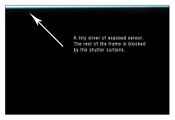Difference between revisions of "Understanding HyperSync and High Speed Sync"
(→Highest Energy) |
(→A flash directly connected to a camera) |
||
| Line 26: | Line 26: | ||
=== A flash directly connected to a camera === | === A flash directly connected to a camera === | ||
| − | |||
| Line 39: | Line 38: | ||
#The flash emits light for the its flash duration. This can be any amount of time up to a few milliseconds. A | #The flash emits light for the its flash duration. This can be any amount of time up to a few milliseconds. A | ||
#The second shutter in the camera closes and both shutters reset. | #The second shutter in the camera closes and both shutters reset. | ||
| + | |||
| + | |||
| + | <center><gallery perrow=2 widths=300px caption="Timing Sequence at X-Sync"> | ||
| + | File:5DMarkII_1.200.JPG|Ranger RX (S Head) at full power, 5D Mark II 1/200th f/22 | ||
| + | File:X-sync_shutter_sequence.JPG|Shutter Sequence at X-sync | ||
| + | </gallery></center> | ||
| + | |||
Shutter speeds faster than X-Sync typically have the first and second shutters moving at the same time, or with no delay between the first shutter fully opening and the second shutter beginning to close. This does not work with normal flash triggering because the second shutter can be moving when the flash is generating light which yields a clipped exposure. | Shutter speeds faster than X-Sync typically have the first and second shutters moving at the same time, or with no delay between the first shutter fully opening and the second shutter beginning to close. This does not work with normal flash triggering because the second shutter can be moving when the flash is generating light which yields a clipped exposure. | ||
| + | |||
| + | <center><gallery perrow=2 widths=300px caption="Timing Sequence at 1/8000th With a Sync Cord"> | ||
| + | File:IMG 4812.JPG|Ranger RX (S Head) at full power, 5D Mark II 1/800th f/22 | ||
| + | File:Non-hypersync_1.8000.JPG|Sync Cord Timing Sequence at 1/8000th | ||
| + | </gallery></center> | ||
Revision as of 18:44, 13 June 2013
| Next recommended reading: HyperSync |
Contents
| Fast Moving Page! |
|---|
| The information on this page is potentially changing hour by hour or day by day as authors are actively generating content. This could be due to a recently improved feature or announcement, or as the result of a large body of behind-the-scenes work coming to fruition. We appreciate your patience as we work hard to bring the best information to you as quickly as we can. |
This section discusses HyperSync and High Speed Sync at a basic level. Read the HyperSync section for more detailed information on how to adjust HyperSync for your configuration.
This page details how flashes function when triggered with HyperSync, High Speed Sync (or Auto FP), and at your camera's sync limit, or its x-sync speed.
HyperSync and High Speed Sync/Auto-FP are not the same thing, and it's important to understand the differences as to how each method relates to your setup.
How Does a Flash Work?
A flash is designed to emit a very intense light for a short duration of time. This is done by filling a flashtube with xenon gas, and then using a charged capacitor to energize the xenon with a very high amount of electrical current.
While appearing to be flash on and instantly turned off again, a flashtube can be excited for anywhere from 1 microsecond to tens of milliseconds. Most consumer flashes usually average around 1 millisecond, with some being longer, and some being shorter.
X-Sync - Flash behavior with normal sync limits
A flash directly connected to a camera
X-Sync is typically the fastest shutter speed at which your camera can trigger a flash. For most Canon cameras, this is 1/200th. For most Nikon cameras, this is 1/250th, except for a few exceptions like the D600.
A camera triggering a flash at X-sync follows this time-line:
- The camera is triggered by the photographer. Several milliseconds of Lag Time pass. The amount of lag time varies from camera to camera.
- The first shutter opens, exposing the digital sensor. Some microseconds of time pass. This shutter will stay open for several milliseconds when the camera is set to its X-Sync speed.
- The camera triggers its PC terminal and the center sync pin on the hot shoe.
- Some microseconds of time pass, then the flash begins to emit light.
- The flash emits light for the its flash duration. This can be any amount of time up to a few milliseconds. A
- The second shutter in the camera closes and both shutters reset.
- Timing Sequence at X-Sync
Shutter speeds faster than X-Sync typically have the first and second shutters moving at the same time, or with no delay between the first shutter fully opening and the second shutter beginning to close. This does not work with normal flash triggering because the second shutter can be moving when the flash is generating light which yields a clipped exposure.
- Timing Sequence at 1/8000th With a Sync Cord
If your flash has a very long duration, or your shutter is very slow moving, you can get clipping even at X-sync.
A flash triggered remotely by a standard radio slave
Adding a standard radio slave to the above time line adds additional microseconds between steps 3 and 4. This additional delay moves the flash triggering moment towards the time when the second shutter will be moving. If your flash has a very long duration, or your shutter is very slow moving, you can get clipping when using a standard radio slave even at X-sync. You may have to use a slower shutter speed.
Users of the 5D series of cameras have especially noticed this, as evidenced by the example to the right.
Users of the PlusX, Plus III, or MultiMAX can select Transmit Only on their transmitter to use a smaller delay, as well as using Receive Only on a Plus III to have the fastest transmission possible.
High Speed Sync
High Speed Sync (HSS), also known as Auto FP Sync, is a speedlight-only technique allows for triggering at shutter speeds faster than X-Sync. "FP" stands for "Focal Plane." When the first shutter starts to open, it is exposing the digital sensor, which is the Focal Plane. FP Sync means triggering the flash just before the focal plane is exposed rather than waiting until shutter is fully open.
HSS/Auto FP uses a pulsed light technique that generates continuous light from before the first shutter begins to move until after the second shutter closes. At faster shutter speeds, both the first and second shutters are moving simultaneously, creating a moving slit across the digital sensor. Since the light appears continuous to the digital sensor, there is no clipping even at the fastest shutter speeds.
HSS/Auto FP requires a special flash like a Canon Speedlite or Nikon speedlight that can do the pulsed light technique. Studio strobes are not capable of pulsing light, a requirement for HSS/Auto FP. This method also requires special timing information from the camera that happens between the user pressing the shutter button and the camera's sensor opening. This information is communicated through the TTL pins of a camera's hot shoe. A normal studio flash or standard non-TTL flash cannot perform the light pulse technique, nor does it have the electrical connections required to use the pre-sync information from the camera's TTL hot shoe pins.
The HSS/Auto FP time line would look like this:
- The camera is triggered by the photographer. Several milliseconds of Lag Time pass.
- Just before the first shutter would open, communications happen up through the camera's hot shoe. This tells the Speedlight when to begin generating pulsed light as ...
- The first shutter opens, exposing the digital sensor while the flash continuously pulses throughout the exposure.
- Shortly after the first shutter moves, the second shutter begins to move. The pulsed light continues.
- The second shutter in the camera closes and both shutters reset. The flash stops pulsing.
The pulsed light technique cannot emit as much light as a normal flash pulse as it uses a lot of energy to make the light continuous. This means that your flash must be much closer to the subject to be effective.
HyperSync
A normal, non HSS-Auto FP flash duration is much more efficient at delivering light to a subject than an HSS/Auto-FP or pulsed flash method. You can have your flash farther from a subject, or deliver more light to the scene when using a normal flash, and use flashes that aren't even capable of pulsing light as required for HSS/Auto-FP.
HyperSync uses special information available in the TTL shoe pins to trigger a normal flash before X-Sync would occur. It does this by knowing how much time passes from these communications until X-sync. It can also eliminate the delay introduced by a radio slave. This is different from the "HSS hack" in that the timing is both adjustable, and can be optimized for some flashes.
HyperSync requires a ControlTL transmitter like the Nikon MiniTT1 and FlexTT5 or Canon MiniTT1 and FlexTT5. Optimizing HyperSync Automation results require a ControlTL receiver like the PowerMC2, PowerST4, or AC9 AlienBees Adapter. All transmitter HyperSync adjustments are made in the PocketWizard Utility on the HyperSync/HSS Tab. Any PocketWizard radio can be used as a receiver and be triggered from the ControlTL transmitter's HyperSync timing, but you will see the best results using a ControlTL receiver.
There are two methods of using HyperSync Automation to get flash sync at faster than X-Sync shutter speeds, Highest Energy and Reduced Clipping. Most flashes generate a tall peak of light when first triggered, then that light fades down to a long tail. The two methods choose when to start the flash in relation to the camera's shutters opening.
Reduced Clipping
Reduced Clipping uses precision timing to keep hard black bars out of your images. This method may result in a gradation across the image (lighter at the bottom and darker at the top), but for many situations, the results are quite acceptable and usable.
- Reduced Clipping
Reduced Clipping benefits photographers:
- Shooting outdoors where the sky is a major factor in the top part of the image
- Using aperture priority in conditions that cause the shutter speed to go above X-sync
- In any situation where the full frame must be used and cropping is not an option
"Reduced Clipping" is selected on the ControlTL receiver, as shown in the section Configuring HyperSync.
- You'd be using this optimized tail HyperSync automatically by choosing Reduced Clipping if you chose this option on the HyperSync/HSS Tab using a ControlTL receiver.
- You'd be able to use Reduced Clipping-style HyperSync manually with a FlexTT5 connected to your flash as a receiver by following the directions for the FlexTT5 P2 Port and trying to eliminate clipping at your highest shutter speeds.
- You can attempt to use Reduced Clipping-style HyperSync manually with a radio receiving on a Standard Channel (meaning a (Plus II, Plus III, PlusX, MultiMAX, FlexTT5 in Basic Trigger Mode), or internal PocketWizard receiver built in to your flash.) This is done by following the directions for the PocketWizard Radio Receiving on a Standard Channel section, and trying to eliminate clipping at your highest shutter speeds.
Note: We do not recommend using Speedlites for HyperSync due to both their short flash durations, and their IGBT design, which makes HyperSync feasible only at full power. HSS/Auto-FP may return more desirable results for users shooting above x-sync with Speedlites.
Read the HyperSync section for more detailed information on how to adjust HyperSync.
Highest Energy
Highest Energy uses precision timing to get as much flash energy into the image as possible above X-sync. This will reduce gradation, but can result in black bars or clipping in the frame. For many photographic situations this can yield acceptable or useful results as clipping can be cropped out of the image.
- Highest Energy
Highest Energy benefits photographers:
- Needing as much action stopping flash power in the image as possible (remember that for HyperSync, longer flash durations are better)
- Gathering images where gradation is not acceptable
- In any situation where cropping is an option
"Highest Energy" is selected on the ControlTL receiver, as shown in the section Configuring HyperSync.
- You'd be using this optimized Highest Energy HyperSync automatically by choosing Highest Energy if you chose this option on the HyperSync/HSS Tab using a ControlTL receiver.
- You can use Highest Energy-style HyperSync manually with a non-ControlTL compatible flash by using a FlexTT5 connected to your flash as a receiver by following the directions for the FlexTT5 P2 Port and trying to put the most flash energy in the frame at lower HyperSync speeds without "clipping" visible at the bottom of your frame.
- You can attempt to use Highest Energy-style HyperSync manually with a radio receiving on a Standard Channel (meaning a Plus II, Plus III, PlusX, MultiMAX, FlexTT5 in Basic Trigger Mode), or internal PocketWizard receiver built in to your flash.) This is done by following the directions for the PocketWizard Radio Receiving on a Standard Channel section, and trying to put the most flash energy in the frame at lower HyperSync speeds without "clipping" visible at the bottom of your frame.
Note: We do not recommend using Speedlites for HyperSync due to both their short flash durations, and their IGBT design, which makes HyperSync feasible only at full power. HSS/Auto-FP may return more desirable results for users shooting above x-sync with Speedlites.
Read the HyperSync section for more detailed information on how to adjust HyperSync.
Factors to consider
There are many factors that change from flash to flash that affect the success of HyperSync.
Flash Duration
- Flash duration is a critical factor. Longer flash durations are better.
- Difference Flash Duration Makes With Otherwise Matching Equipment
Power Level
- Flash duration often changes with power level. When you are fine-tuning HyperSync, make sure to test across the flash power levels you intend to use so you can see if certain flash durations will cause clipping at any shutter speed you intend to use. For a great comparison of how important flash duration is, see the 5D Mark II results for HyperSync with a Ranger RX Pack with an S head, and the results with a Ranger RX Pack with an A head. It's the same pack, same camera, but the flash duration is much, much shorter with the A head, and has a very noticeable visual effect. You can see these images on our Camera HyperSync results page
- Difference Power Level has on Flash Duration
Shutter Blade Travel Rate
- Cameras with slower larger shutter blades will make HyperSync less likely to work without noticeable gradation. Faster shutter blades, smaller sensors, or crop mode can often improve HyperSync success by minimizing gradation.
- Camera Choice
Camera Communication Time
- Some cameras communicate up through their shoe to give the radios a larger window of opportunity for adjustment, resulting in no "clipping" at the bottom of the frame, and some do not, resulting in "clipping" at the bottom of the frame.
- Communication Time Limitation
What do I do to find out what results I'll get with my camera and flash?
Thankfully, we've done a lot of the guess work for you, the customer, by shooting as many cameras as we can with as many ControlTL compatible flashes as we can. You can see those here: Canon and Nikon Camera HyperSync Results


















